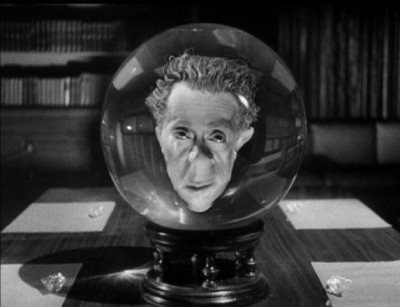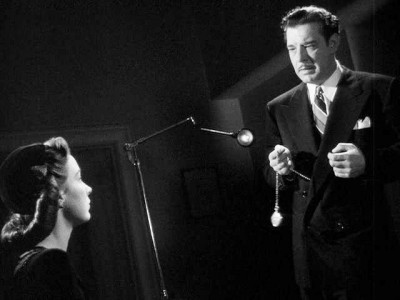
This started out to be a makeup show for the double feature that was “snowed out” (or so Mr, Weatherman claimed). But since about 20 intrepid souls Nanooked their way to that and the films ran, it was decided to split the makeup show into two shows, repeating only one film each time. As a result, what we have here is both Calling Dr. Death (1943) and Invisible Ghost (1941) — and it is noteworthy that this is a better copy of Invisible Ghost than the one screened earlier. So, once again, it’s a pairing of one of Lon Chaney Jr.‘s “Inner Sanctum” mysteries and one of Bela Lugosi’s notorious Monogram Nine. (Originally, it was The Frozen Ghost and Invisible Ghost, two movies with the word “ghost” in the title but not actually in the film. This time it’s two guys who can’t remember whether or not they’ve killed someone.)

Calling Dr. Death is the first of the Inner Sanctums — that peculiar run of movies Universal came up with (always opening with that head in the crystal ball) that were loosely (very loosely) tied to a popular radio show and which could be played as either noir-like mysteries or light horror. They were cheap and gave their new horror star Chaney something to do. While the connection the radio program was tenuous, it’s interesting to note that the movies sound like radio dramas with organ-music-heavy soundtracks and the business of Chaney “thinking” aloud. The latter was always a stretch — as was the idea here that ol’ Lon was a neurologist. They could pack our beefy hero into nicely tailored suits, give him a pencil-thin mustache and an array of flamboyant neckties, but he still came across more as a stagehand who wandered onto the set than an intellectual sophisticate. And it was worse whenever he spoke — and he does an awful lot of speaking in these pictures. But — and this is the key — there’s something endearing about the whole thing — like watching a waltzing bear.

Truth is, the movies are — by and large — better than they had to be. Production values aren’t that shabby (when there’s a studio at hand with standing sets, a good prop department, and a good costume department, that’s not that hard). The photography is up to A picture standards, and there’s the appeal — especially if you grew up on this stuff — of that recycled Universal music. Just as important, though, is the fact that the directors really seemed to try to make up for the films’ other shortcomings. (The biggest problem is that the casts are too small to make for effective mysteries. The choices for whodunit are distressingly limited.) In Calling Dr. Death, Reginald LeBorg stages one lengthy scene using point-of-view camera (I’m not sure it really adds anything, but it looks cool) and otherwise lays on the occasional Dutch angle and includes a pretty spectacular nightmare where buildings start to close in on the murderer. Great stuff? Probably not, but it’s the kind of thing that makes you feel that at least someone was really trying to make a good movie.
For more on Invisible Ghost go to: http://avl.mx/rc
The Thursday Horror Picture Show will screen Calling Dr. Death and Invisible Ghost on Thursday, March 21 at 8 p.m. in the Cinema Lounge of The Carolina Asheville and will be hosted by Xpress movie critics Ken Hanke and Justin Souther.




Before you comment
The comments section is here to provide a platform for civil dialogue on the issues we face together as a local community. Xpress is committed to offering this platform for all voices, but when the tone of the discussion gets nasty or strays off topic, we believe many people choose not to participate. Xpress editors are determined to moderate comments to ensure a constructive interchange is maintained. All comments judged not to be in keeping with the spirit of civil discourse will be removed and repeat violators will be banned. See here for our terms of service. Thank you for being part of this effort to promote respectful discussion.